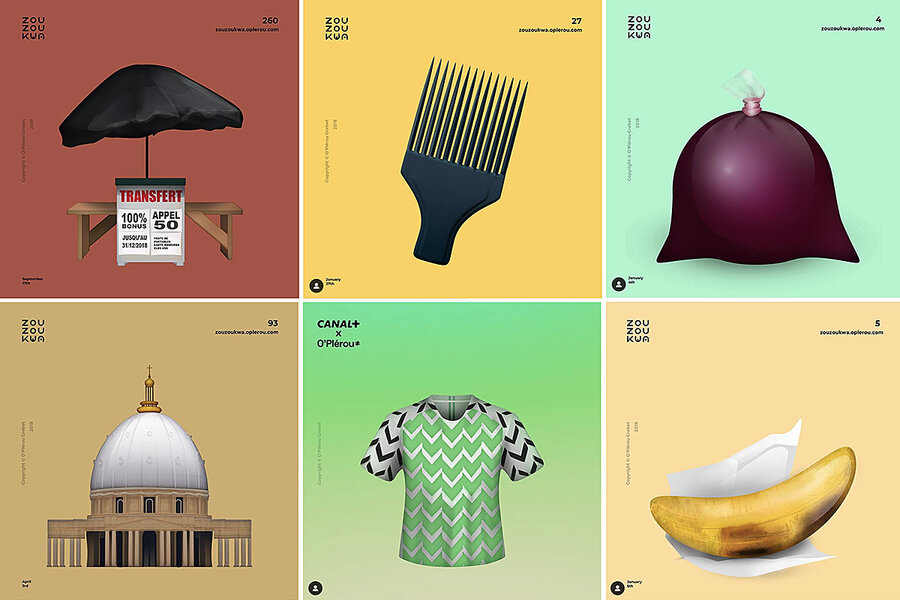Drawing West Africa, one emoji at a time
Loading...
If you’re in Ivory Coast, how do you say “I told you so”?
Well, there are as many ways as the country has languages – a couple dozen, at least. But you could also just point to your left eye. It’s the kind of simple, common gesture that seems practically made for emojis.
Why We Wrote This
What isn’t there an emoji for? A lot, it turns out – if you don’t come from the culture where most “official” emojis are made. So one student set out to change that.
And today, it is an emoji, thanks to a young man named O’Plérou Grebet. On Jan. 1, 2018, when he was a student, Mr. Grebet resolved to draw a distinctly West African emoji a day and post them on Instagram.
What began as a fun project quickly took off, helped along, he thinks, by West Africans’ desire to see themselves reflected back in the tiny images that have become a second language to phone users around the world.
“The goal was to share African culture in a colorful and different way,” he says. “I didn’t have any idea that people would like it so much.”
Today, his images are available in an app – from his favorite grilled plantains to the silver dome of an Ivoirian basilica, the world's largest church.
It started with a New Year’s resolution fit for the 21st century.
On Jan. 1, 2018, Ivoirian graphic design student O’Plérou Grebet vowed to create an emoji a day for 365 days – each of them depicting some element of life in Ivory Coast or West Africa more generally.
He named his project Zouzoukwa, meaning “picture” in Bété, his mother tongue, and began posting his creations to his Instagram, @creativorian.
Why We Wrote This
What isn’t there an emoji for? A lot, it turns out – if you don’t come from the culture where most “official” emojis are made. So one student set out to change that.
Scouring his own life for inspiration, Mr. Grebet started with his favorite snacks – like the grilled plantains wrapped in paper he bought from street vendors and the tiny plastic sacks of tart, sweet purple hibiscus juice he used to buy on his way to school. Then came the comb for his Afro and the zig-zaggy green and white jersey of the Nigerian national soccer team. He drew bags of hair extensions, kiosks selling cellphone airtime (“the best place to learn all the neighborhood affairs,” he wrote in the caption), and the silver dome of the Basilica of Our Lady of Peace, an Ivoirian church certified by Guinness World Records as the largest in the world.
“The goal was to share African culture in a colorful and different way,” he says. “I didn’t have any idea that people would like it so much.”
But the project took off, helped along, Mr. Grebet thinks, by West Africans’ desire to see themselves reflected back in the tiny, intricate images that had become like a second language to his generation. Despite the growing number of skin colors, professions, foods, and other types of emojis on their phones, after all, it was still clear the usual set of emojis was created by and for people who didn’t look like them.
“People like to see the elements of their own daily life in their phone,” he says. “And it’s funny to have expressions that really correspond with the ones you use yourself.”
Take Zouzoukwa #78, a cartoon face pointing to his left eye, an expression that in Ivory Coast means “I told you so.”
“An emoticon that our African parents are going to love,” quipped one commenter.
By the time Mr. Grebet finished his emoji challenge in December 2018, the project had taken on a life of its own. His creations were winning graphic design prizes, and French TV channel Canal+ had enlisted him to create special emojis to use on social media during the 2018 World Cup.
An advertising agency sent him a MacBook to use to make his designs, and in January 2019, one year after the project first premiered, it became an app. Now, users can embed Zouzoukwa images as “stickers” in their text message or WhatsApp conversations.
By October of this year, the same month Mr. Grebet graduated with a degree in digital arts and images from the Institute of Sciences and Communication Techniques in Abidjan, the Zouzoukwa app had been downloaded more than 100,000 times. Next, Mr. Grebet says he would like to submit some of his designs to Unicode Consortium, the gatekeepers for the “official” set of emojis that comes standard on most smartphones.
And then “I want to extend the project,” he says. “Travel to other countries, immerse myself in their cultures, and then transform them into emojis.”








